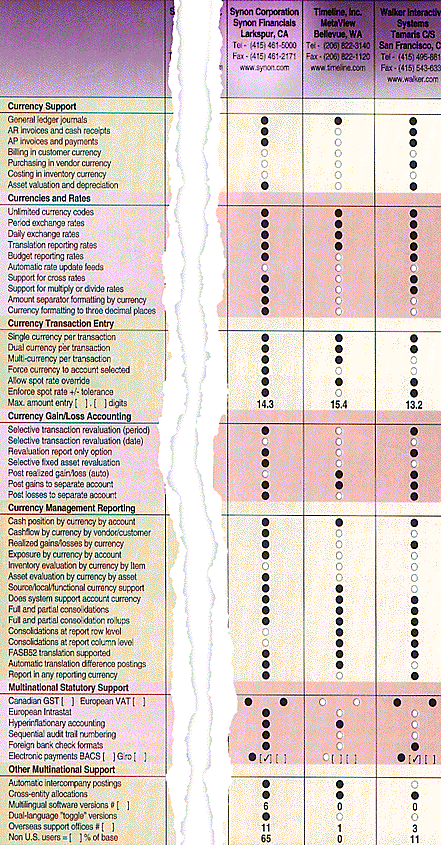Traditionally, multinational accounting has been associated with enterprise-level accounting packages targeted at Fortune 1000 organizations. Costly to buy and implement, these packages were out of reach of most businesses with revenues under $250 million. Because of this cost, may companies were forced to manage multinational accounting outside the core accounting GL, AR, and AP modules by using spreadsheets and other tools. However, much has changed in the past 10 years, and this section will provide an overview to bring you up to date on the multinational accounting market.
Out of necessity, European vendors have focused on multinational accounting far longer than U.S. vendors have. To sell pan-European systems required multinational functionality, and vendors based in single European countries did not have the vast domestic accounting systems market open to U.S. vendors. That's why vendors such as Systems Union in London introduced multicurrency functions into its financial packages more than a decade ago. These European vendors often have sophisticated sales and support networks for distributing their products outside the U.S., thousands of installations spread throughout many countries, and strong reseller channels in their home markets.
While U.S. enterprise accounting software vendors such as Dun & Bradstreet Software, Systems Software Associates, J.D. Edwards, Computer Associates, and Oracle Corp. have long offered some form of multicurrency functionality in their accounting systems, they have also focused on delivering broad and deep enterprise-level multinational functionality (e.g., allocations, consolidations, treasury management, and intercompany accounting). This functional breadth and depth comes at a price: higher software acquisition costs and ratios of software dollar cost to implementation dollar cost of up to $1 to $5, or even higher. Typically, these vendors also offer broad and deep sales and support for their systems in various key overseas market areas including Europe, the Pacific Rim, and South America.
Only in the past few years have popular U.S. middle market vendors such as Great Plains Software, Platinum Software, and Solomon Software begun to deliver multicurrency and other limited multinational functionality to their accounting software. In many cases, this functionality is delivered only in their new Client-Server accounting suites and then, initially, it is often restricted to the accounts receivable and accounts payable modules. Apart from the relative immaturity of this functionality, the other issues these newcomers face is the lack of multinational expertise in their domestic reseller channels and the relatively shallow breadth and depth of their overseas sales and support facilities.
Multinational application functionality is only one part of a multinational accounting solution. An equally important part is the distribution, implementation, and support services provided by the vendor or its partners to deliver the solution. When you evaluate a multinational accounting package, you should examine the following aspects of a vendor's offering closely, especially when evaluating a multisite solution for deployment outside the U.S. For distribution, which affects how the software is sold:
For implementation, which affects how the software is deployed and brought into use:
For support, which affects how the software is maintained:

Back to SMA Articles and Press Relases
|
©1995-98 Synon Corporation. All rights
reserved. |